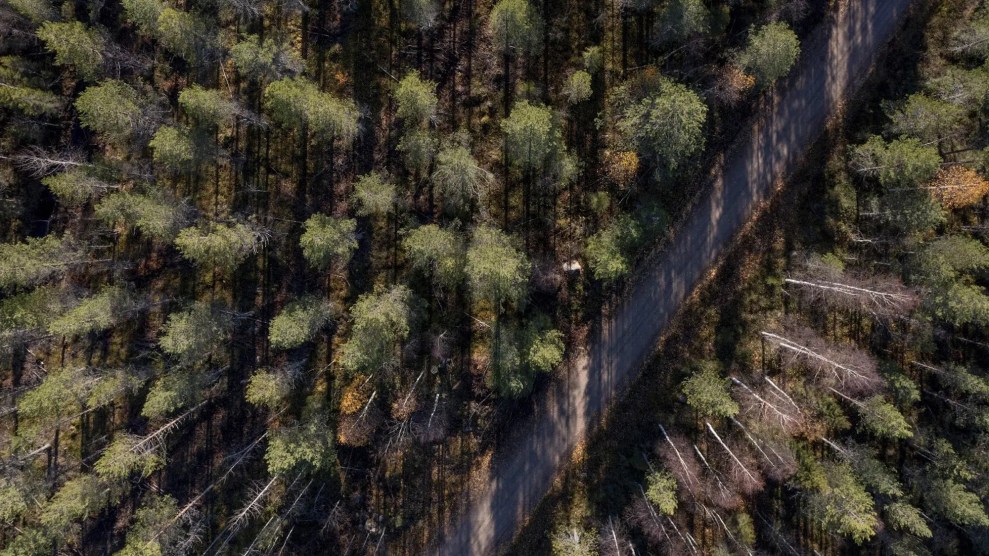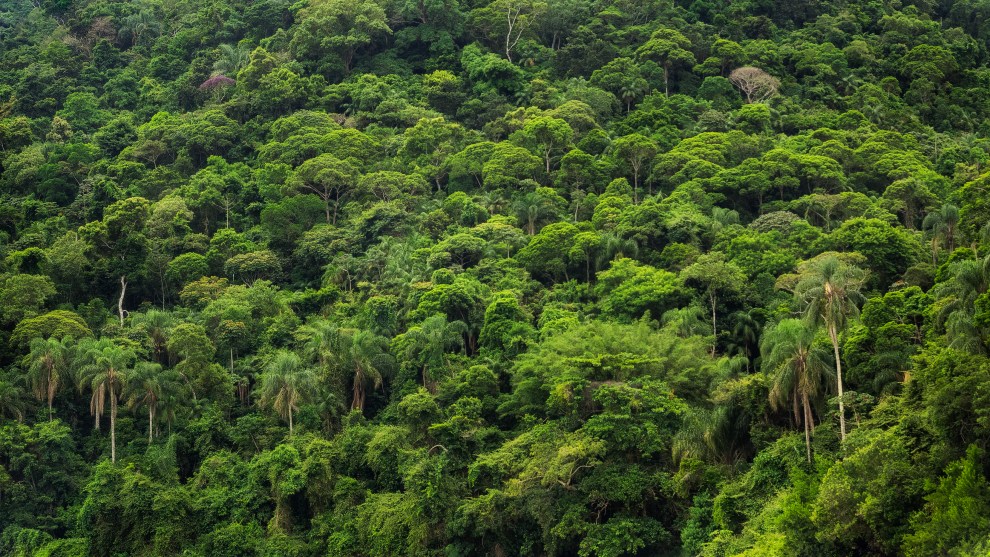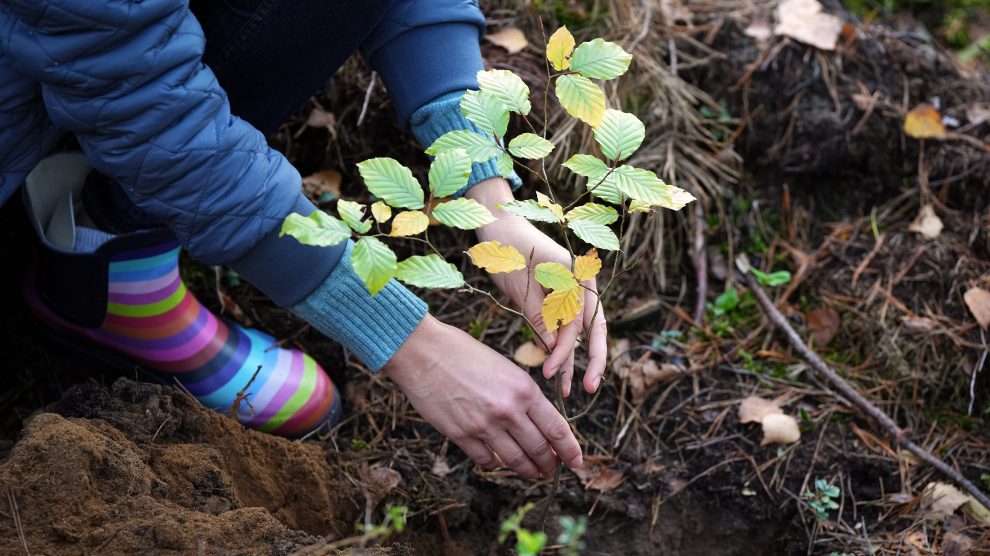
Olivier Morin/AFP/Getty/Grist
This story was originally published by Grist and is reproduced here as part of the Climate Desk collaboration.
What is the value of a tree? It can provide a cool place to rest in the shade, a snack in the form of fruit, lumber to build a home, and cleaner air. But trees are increasingly being prized for one thing: their ability to capture carbon and counteract climate change.
Billions of dollars are flowing into projects to plant and protect trees so that governments and businesses can claim they’ve canceled out their emissions. Saving forests and planting trees are often portrayed as a “triple win” for the environment, economy, and people. According to a major report being presented on Friday at the United Nations Forum on Forests, however, that goal is proving more complicated than expected.
The conversation about how to manage forests “has been overtaken by the climate discussion,” said Daniela Kleinschmit, an author of the report and the vice president of the International Union of Forest Research Organizations, the network behind the research. The result? Indigenous peoples are getting pushed out of their lands because of carbon offset projects. Native grasslands are getting turned into forests, even though grasslands themselves are huge, overlooked reservoirs of carbon. And offset projects in forests, more often than not, fail to achieve all of the emissions benefits their backers had promised.
The new report, the first comprehensive assessment of how the world is governing its forests in 14 years, offers some good news—global deforestation rates have slowed down slightly, from 32 million acres a year in 2010 to 25 million in 2020. But what the report calls the “climatization” of forests has led to the rise of carbon sequestration markets that prioritize short-term profits over long-term sustainability, it found.
Experts say that it’s possible to pursue the global goal of sequestering carbon in forests while also keeping locals happy—it would just take a more thoughtful approach that considers the tradeoffs and involves the people most affected.
Daniel Miller, a professor of environmental policy at the University of Notre Dame, said that a narrow focus on forests’ environmental benefits misses “a huge part of the story.” Miller’s research has shown that forests can help fight poverty, since the edible goods found in them are often available during times of the year when people might go hungry. Having forests nearby can make land more productive, increasing crop yields by more than 50 percent in some cases. That’s because forests can enrich the soil, increase rainfall, and help with pollination. More than 3 billion people live within 1 kilometer (a little over half a mile) of forests and depend on them for jobs, like harvesting timber, and for food like nuts and mushrooms.
Forests can also help people adapt to a warming world. They regulate floods and landslides and sustain livelihoods that are jeopardized by climate change, said Ida Djenontin, a professor of geography at Penn State.
But what looks like a promising carbon sequestration effort can have unexpected consequences that undermine those benefits. For example, Finland’s ministry of agriculture is trying to fertilize its forests to make them grow faster, in the hope that they will suck up carbon quickly and help the country meet its goal of going carbon-neutral by 2035. But according to the new report, the government didn’t account for the energy-intensive process of producing and transporting fertilizer, a large source of carbon emissions. The report also points out that fertilizing forests can end up hurting reindeer herding, since it stifles the growth of lichen that reindeer eat; one study found that it could also reduce berry production in forests by 70 percent. “It seems that the ongoing climate crisis has, to some extent, legitimized excessive forest management techniques, such as fertilization,” the report concludes.
Many forest offset projects don’t work as intended. An investigation last year found that only eight out of 29 rainforest offset projects approved by Verra, the world’s biggest certifier, had meaningfully reduced deforestation. The rest of the projects “had no climate benefit,” according to The Guardian, partially because the threat of those forests getting cut down had been vastly overstated.
The narrative that forests can save the world from climate change is a tempting one for businesses and politicians—they can seemingly take care of their climate pledges if they’re willing to fork over the money, without having to do the hard work of reducing emissions. It also allows people to skip the hard conversations about cutting down on consumption, Kleinschmit said. The market for voluntary carbon offsets—the ones companies choose to buy—is predicted to grow from around $2 billion in 2021 to $250 billion by 2030.
Another problem is that “carbon cowboys”—a term for those seeking to profit off carbon offset schemes—can end up evicting Indigenous peoples from their homes. In 2015, Cambodian officials set aside more than 1,900 square miles of rainforest in the country’s Cardamom Mountains for a carbon offset project without consulting the Chong people that had lived there for centuries. Villagers were forced from their lands, and some were even arrested for collecting resin from trees, since carbon offset areas were monitored to stop locals from using the forest’s resources.
In the United Arab Emirates, the company Blue Carbon has negotiated deals for millions of acres so it can launch offset projects aimed at protecting forests across Liberia, Kenya, Tanzania, Zambia, and Zimbabwe. Much of that land has been held by Indigenous peoples. Since 1990, an estimated quarter-million people around the world have been pushed out of their homes in the name of conservation.
Global climate goals, of course, don’t have to come into conflict with local needs. Experts say it’s possible to balance the two effectively. Prakash Kashwan, an environmental studies professor at Brandeis University, said that locals can use resources from trees, at least on a smaller scale, without hurting a forest’s ability to sequester carbon, according to his research. Studies have demonstrated that involving Indigenous peoples and local residents in the process of decision-making is key to better social and environmental outcomes—including carbon sequestration.
“Allowing communities a say in how forests are managed is absolutely vital to more effective, lasting, and just forest governance, and for tackling these big global challenges that we face,” Miller said.














